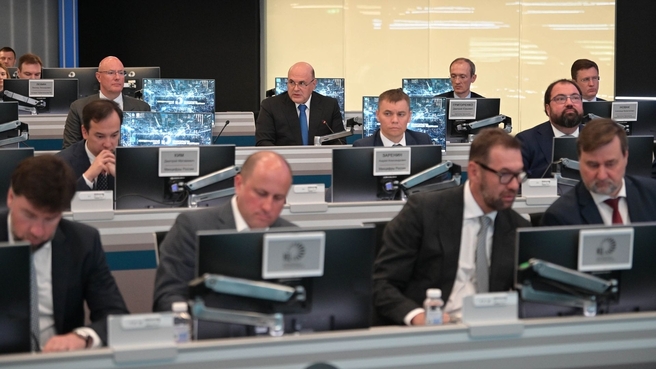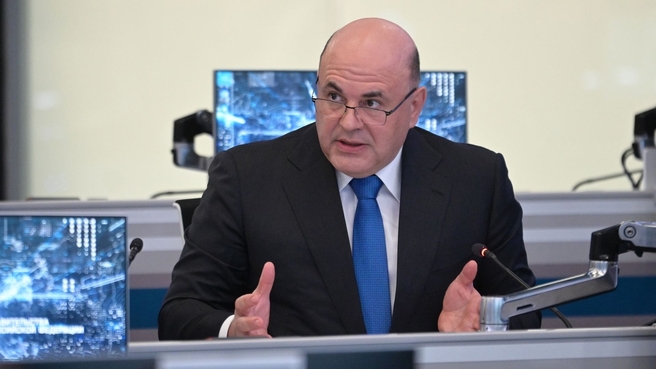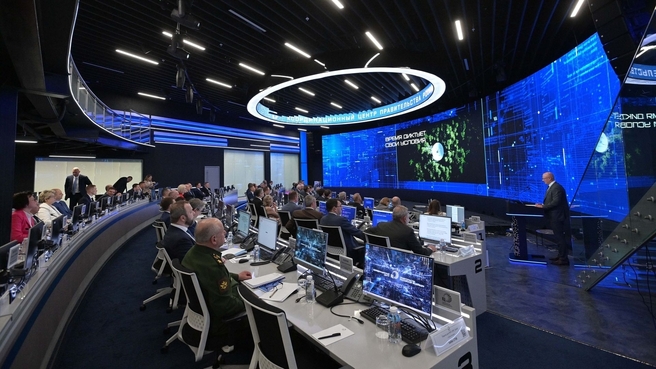Mikhail Mishustin: “Under the President’s instruction, the Government has developed a draft long-term strategy for the telecommunications industry development. The strategy is based on a consistent approach to building an up-to-date information infrastructure in view of the current challenges and restrictions. The infrastructure will rely on domestic telecommunications systems and equipment.”
Mikhail Mishustin’s opening remarks:
Mikhail Mishustin held a strategic session on the telecommunications industry development until 2035
Good afternoon, colleagues.
Under the President’s instruction, the Government has developed a draft long-term strategy for the telecommunications industry development.
The strategy is based on a consistent approach to building an up-to-date information infrastructure in view of the current challenges and restrictions. The infrastructure will rely on domestic telecommunications systems and equipment.
The strategy will become a significant aspect of strengthening technological sovereignty the President has spoken about.
The strategy was developed in cooperation with major Russian companies, industry experts and associations. Today we will discuss the new initiatives in detail. We have several tasks on the agenda to solve.
Allow me to elaborate.
First of all, people must have access to quality telecommunications services and internet access all across the country, including in remote areas, small towns, territories along motorways and railways. Unfortunately, when we visit Russian regions, we can see that these services are not equally accessible nor provided to equal standards, as confirmed by local residents and students. The situation with schools has improved but it is still very challenging due to many towns and villages across the country being located in remote areas. The demand for such services is constantly rising as they have become part of our everyday lives just like electricity, heating and hot water. Seventy-five percent of Russian citizens aged 18 and older use WiFi at home and mobile internet on a daily basis.
However, not everyone has access to modern technologies, as I have said. The President has set us a clear goal: to increase the share of households with broadband access to the internet to 97 percent by 2030. It is one of the main indicators of the achievement of the national development goals. The current figure is 86 percent, which is quite good considering that the planned target is 81 percent.
During his address at the St Petersburg International Economic Forum last week, the President mentioned the need to provide high-quality communications and internet access in all communities that have between 100 and 500 residents.
This goal must be achieved within seven years. During the first stage, communities with over 250 residents were to be connected. It was finished 18 months ago.
Today we are building telecommunications infrastructure in small villages with fewer than 100 residents. Moreover, we are building 4G networks there to ensure access to high-speed LTE internet.
Of great importance for this project was a large-scale programme of connecting socially significant facilities to the network. In the three years since its inception, over 75,000 facilities have been connected, two thirds of them in rural areas, such as primary care centres, which helped improve the quality of medical services, as well as schools, colleges and libraries. This has given young people more opportunities to acquire new knowledge.
Overall, these measures have helped increase the number of people with access to the advantages of the internet for receiving public services to 100 million. To date, about 200 public services are available online.
Recently, internet traffic has been increasing by about one-third every year. The greatest growth was recorded in the initial period of the coronavirus pandemic, when people began doing more things online. This does not only include working or studying, but also watching videos, listening to music, and using other kinds of content. To date, those trends have seriously advanced the use of such technologies, including remote access solutions. We began to use more video communication, video conferencing and other such applications. The collection of information has become better structured, technologically. Therefore, the next significant objective is the accelerated development and implementation of the most advanced domestic solutions to ensure high-quality modern communications and faster, more reliable internet access.
To do this, providers need to upgrade their networks to increase their bandwidth and data transfer rate. They need to ensure the high stability of communication channels, and their protection from cyber attacks and external interference.
Appropriate competencies and technologies are to be fostered and promoted. It is clear to everyone by now that we cannot stop at providing LTE standard mobile services. It is important to shift to new generation communication networks faster. Therefore, colleagues, we need to strengthen relevant scientific research, which is something we have been discussing for years.
True, the disruption of foreign telecom equipment supplies is posing certain challenges, especially in the mobile segment, where Western solutions were traditionally used.
To speed up the transition to Russian base stations for LTE and 5G, the Government and market participants have adopted a roadmap for the development of modern networks. It includes several state support programmes, including 3.5 billion roubles in subsidies for the manufacture of the required high-tech devices to be allocated this year.
Most importantly, we have resilient manufacturers who are able to attain these objectives. Therefore, I am sure that we will cope with this challenge.
Colleagues,
What I suggest doing during today's meeting is exchanging views on the development targets for the industry and on possible risks. If necessary, we will consider additional state support measures. I am also interested to hear your ideas and suggestions concerning improvements to the training programmes for relevant specialists, taking into account the latest standards for telecom operators.
We have already discussed our approaches more than once and have drawn up a certain plan of action.









